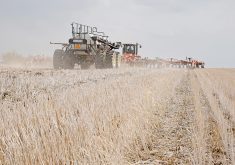A new rule that recently came into effect allows for the immediate expensing of certain assets in the year that they were purchased. This is optional and substitutes claiming capital cost allowance at the prescribed rate over multiple years.
Originally only available to Canadian-controlled private corporations (CCPCs), the proposal has been updated to include unincorporated businesses as well, such as sole proprietorships and partnerships.
This new rule grants taxpayers the opportunity for tax planning regarding the timing of asset purchases. I am outlining key attributes of the immediate expensing rule to help you identify possible planning opportunities to discuss with an adviser.
Read Also

Budget seen as fairly solid, but worrying cracks appear
The reaction from the agriculture industry to prime minister Mark Carney’s first budget handed down November 4th has been largely positive.
The limit that can be immediately expensed is $1.5 million per year. Keep in mind that this $1.5 million limit is shared between associated parties. This means that if your farm is part of a group of companies, association rules need to be reviewed to ensure that this limit is not exceeded for the group. The group can choose to allocate most or all of the limit to the entity with the highest income. Remember that any unused portion of the limit cannot be carried forward.
There are certain classes of assets that are excluded from the immediate expensing option. These prohibited assets are generally long-lived assets. Typically, this includes buildings and intangible assets that have long useful lives. Assets that fall into these categories will be subject to the normal CCA rates and claim rules, including the half year rule on the year of the purchase.
Immediate expensing is available for eligible property acquired by corporations on or after April 19, 2021, and becomes available for use before Jan. 1, 2024. For individuals and certain eligible partnerships, immediate expensing is available Jan. 1, 2022, for eligible property that becomes available for use before 2025.
Some examples of items that would be eligible are general farm equipment, automotive and power equipment as well as office equipment including computers. Any assets that fall into these categories are eligible to be immediately expensed in the year that they are purchased and available for use.
Now ask yourself what happens when you are ready to sell these assets? When the asset is eventually sold, the undepreciated capital cost (UCC) of your pool of assets will be lower than under the previous CCA rules. Therefore, any proceeds from the sale of the fully expensed asset could result in what is called “recapture of overclaimed CCA”. Whereas, if the asset would have been depreciated using prescribed rates over several years, there would have possibly been an ending UCC balance or cost to offset the “recapture” or possibly even create a loss. Tracking assets becomes very important under these new expensing rules. If you plan on selling the asset in the next year or two you might want to discuss the tax implications with your trusted adviser.
You can now see how important the timing of asset purchases can be when it comes time to using the full potential of the immediate expensing options available to your farm operation. For example, if there is anticipation of high revenues in the coming year, it could be in the best interest of the farm to make some asset purchases that can be immediately expensed in that year. If the farm is associated with others, then there is also merit in finding the most tax effective way to split the $1.5 million.
Having this optional expensing item available to you will help at year end when looking for ways to lower the tax bill for your farm. These rules are new and complex; therefore, it is beneficial to discuss with your trusted tax adviser to determine how to use these rules to your advantage.
Colin Miller is a chartered accountant and partner with KPMG’s tax practice in Lethbridge. Contact: colinmiller@kpmg.ca.















